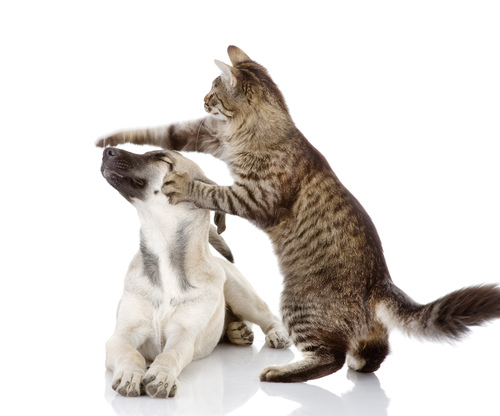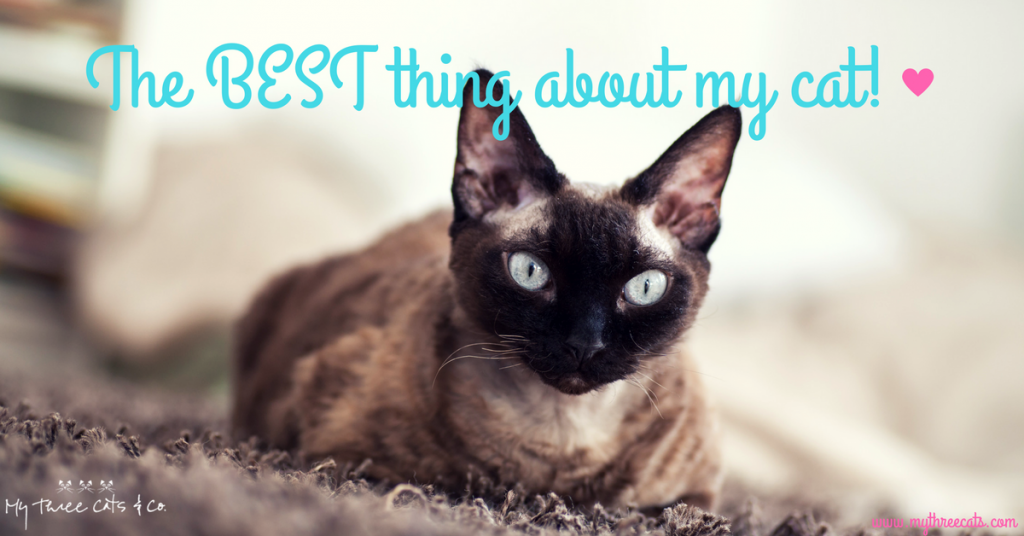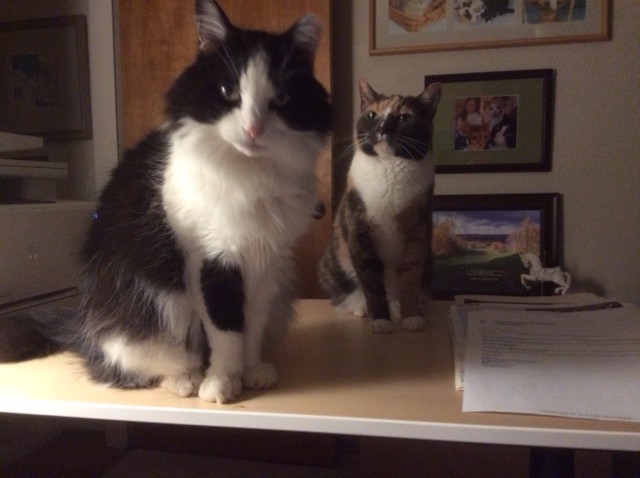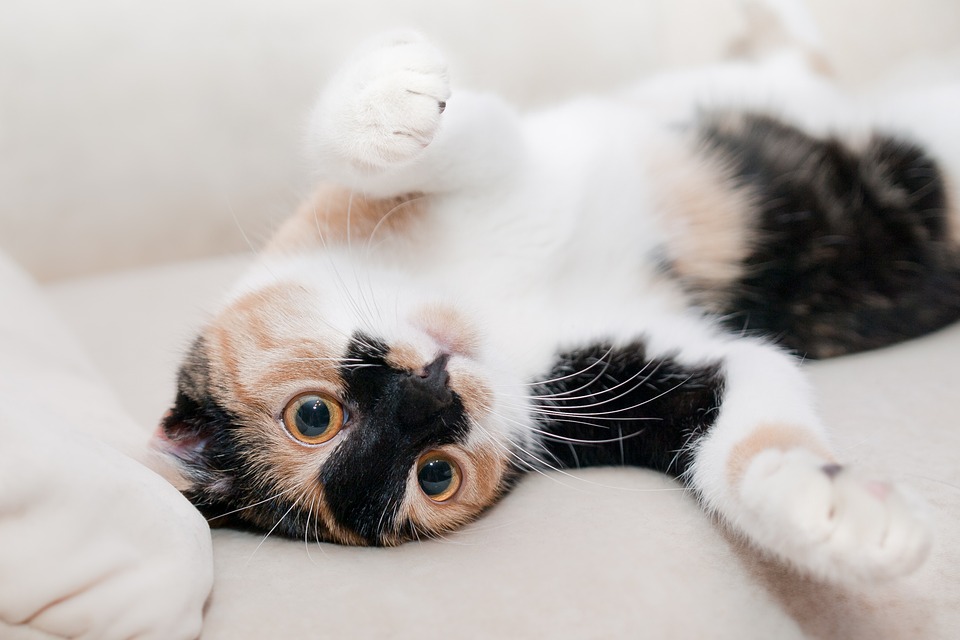Category: multiple cat homes
It’s all about Me-owww! Techniques Cats Use To Win Our Attention
It’s 11:00PM. You’re up against a deadline to finish a report for work. You’ve just belted down a strong cup of coffee and you’re on the home stretch. One more section to go and you’re done! Hmmm, you think to yourself, the cats have been amazingly quiet.
Just as you touch your keypad, something distracts you out of the corner of your eye. You glance over your shoulder. There they are – both of them – perched atop your side desk, staring at you. Their stare isn’t just any casual gaze. Their eyes are large, round, intense and compelling, their stare unwavering. You know what they want – your undivided attention!
What is it about cats that drive you to stop whatever you’re doing, and attend to their every whim?
Cats are intelligent creatures. Once they figure you out (which doesn’t take very long), you’re putty in their little paws. They know exactly what to do and they do it. If you make the fatal mistake of catering to them the first time, they will repeat the process again and again, and you’re hooked.
Here are just a few of the many techniques employed by the cats in my household (or, should I say, theirs).
- The Stare Down. It works every time. It elicits a response something like, “Hey cutie, what is it? What do you want?” Bingo!
- The Wait. They wait patiently in the kitchen until they see a human approach. From that point forward, it’s a steady litany of me-owwws, some extremely lengthy and desperate. They don’t let up until you put the food bowls down, with their dinner just the way they like it. Success!
- The Hit and Run. You’re reading a magazine on the couch, your collection of magazines neatly stacked in front of you on the coffee table. Out of the blue streaks a wild cat, leaping onto the stack, scattering them halfway across the room. You slap down the magazine and get up to fix the mess. The me-owwws start, with longing looks towards the kitchen. Mission accomplished!
- The Toy Closet Vigil. My cats know where I stash their wand and laser toys. If I am within an ear shot of “the” closet, they assemble like soldiers in front of it. If I start to walk past them, they begin lightly scratching on the closet door, elevating to full, obnoxious scratching, however long it takes. Fifteen minutes later, after a decent play session, they nonchalantly saunter away while I’m still waving the toy, collapse on the floor, and casually survey the room as if to say, “You can put that thing away now…I’ll let you know when I’m ready to play again.”
- The Heart Stopper. This works something like the Hit and Run, only you’re lucky to survive. In the middle of the night, you’re experiencing a deep REM sleep. Your feline 757 lands with a thundering thud on the bed, skipping to the end of the runway, heading directly into your face. Not only do you wake up with heart palpitations, you wake up to a set of wild, black pupils staring into yours. After convincing yourself it’s not a nightmare, you desperately try to fall back asleep. That’s when they repeat. You get up. They me-owww, you follow them, tripping down the stairs into the kitchen. This is a win-win (for the cat, not for the two of you)!
If you haven’t yet experienced any of the above, it’s probably because you have cats that have employed other techniques that have proven successful, or else you’ve just adopted a cat today who hasn’t yet figured you out. Don’t worry – he’ll have you “trained” by the end of the week, and you won’t even know it!
Wanted: Cats Who Act Like Like Dogs- Why Not Cats Who Act Like Cats?
 AOL.com recently posted an article about dog people who prefer a cat who has their canine’s “extroverted playfulness”, compared to a cat who displays “quiet affection.” They like cats who will fetch; go swimming; come to you when called by name. They then proceed to list all of the purebreed cats whom they say act like dogs, like the Maine Coon, Burmese; Ragdoll; Burmese; Manx and others.
AOL.com recently posted an article about dog people who prefer a cat who has their canine’s “extroverted playfulness”, compared to a cat who displays “quiet affection.” They like cats who will fetch; go swimming; come to you when called by name. They then proceed to list all of the purebreed cats whom they say act like dogs, like the Maine Coon, Burmese; Ragdoll; Burmese; Manx and others.
While I understand the point, it somehow doesn’t sit quite right with me.
I don’t believe the notion that only certain breeds of cats are extroverted or playful, to the exclusion of all other cats.
First, just like you and me, and the dogs in our lives, each cat has a distinctly unique temperment. There may be characteristics we think are common to some types of purebred cats. And, not just in the case of purebreds but in the case of mixes – you’ve heard of a calico cat’s “catitude” or an orange tabby’s easy going temperment. However, in the final analysis, their background, upbringing and interactions with humans have significant bearing how they act as adult cats, forming their unique personality traits.
Having said that, from observing and interacting with many types of cats over my lifetime, it’s very obvious to me that far more (socialized) cats have a playful, receptive personality than not. Interestingly enough, the regular garden variety of cats, like tortoiseshells or tuxedos especially follow this pattern. They, like their canine counterparts, co-habitate well with other household pets; are energetic and playful; and like interaction with humans. However, just because cats are “quietly affectionate”, doesn’t mean there isn’t a perfect human match for them out there as well!
The long and short of it is…let’s not stereotype our feline friends! Finally, let’s celebrate their uniqueness and realize there is a place in our lives for the adventurous Tigers as there is for the quiet, affectionate Lilies.
How to be the best cat owner you can be
Guest Blogger: Jessica Brody –http://www.ourbestfriends.pet. Jessica enjoys writing about cats and dogs. See her blog for additional photos and posts).
A cat is a great pet who can be just as loving a companion as a dog. It’s important to know, however, that cats are not dogs. They react differently to situations, learn and “train” differently, and require differing approaches to care. Here are some tips for being a great cat owner.
Know how to properly feed your cat
Cats are carnivores, plain and simple. You can’t feed your cat a vegan diet and expect it to stay healthy.
“Money saved by buying cheap cat food will be spent hundreds of times over on veterinary care. Cats are obligate carnivores and need a good source of meat protein. They do not need large amounts of grain fillers, especially corn, which is a cheap source of protein used by many cat food manufacturer,” notes The Spruce.com.
Check your cat’s stool. If it appears too dry, you might want to switch to a wet food diet for a while or at least alternate between wet and dry food throughout the week.
And remember – don’t feed your cat milk, despite what all of the cartoons say. It can be harmful to them in many cases.
Make sure your cat gets enough exercise
It’s a myth that cats don’t need exercise. Sure, they don’t need as much as a dog – but cats that don’t exercise can develop a bevy of health problems, including heart disease and obesity.
… How do you ensure that your cat is getting enough exercise? The best way is to simply play with them for 15-30 minutes. If you have a fenced-in backyard, let them run around for a while. Make use of laser pointers. Your cat really will chase them for a long time. If your cat is suffering from obesity…talk to your vet about this more extreme exercise plan.
Give them a place to scratch
Cats will scratch. Like death and taxes, it’s a certainty of life. Make sure your cat has plenty of scratching posts to utilize. Never ever consider declawing a cat, even if they live indoors 100% of the time. It’s inhumane.
Ensure pet family cohesiveness
One of the biggest challenges cat owners face is making sure the cat gets along with the other household pets – usually a dog. It’s important to remember that dogs and cats socialize in different ways, so “training” your cat the same way you trained your dog is not likely to have an effect on their behavior.
What you need to do is be mindful of the energy of the animals in your household. “It’s your responsibility to keep the family balanced by keeping the dog at the highest level of calm-submissive behavior, allowing the cats to become calm-assertive in front of him,” notes famed trainer Cesar Millan.
If your cats are showing aggression toward each other, it’s a different story with a different set of solutions. First, you should never let cats work through their issues with fighting. It just doesn’t work like that for them.
“Never let the cats ‘fight it out.’ Cats don’t resolve their issues through fighting, and the fighting usually just gets worse. Interrupt aggression with a loud clap of your hands or spray from a water gun,” says the ASPCA.
Once you separate your cats just leave them alone. Don’t try to soothe them the way you might try to calm a dog. You can also try to separate your cats’ resources – food, water, and toys.
Do your research on proper cat care. There are a lot of myths out there about cats, and some of them can be harmful.
Photo Credit: Pixabay.com
(Editor’s Note: The opinions, beliefs and viewpoints expressed by guest bloggers on this web site do not necessarily reflect the opinions, beliefs and viewpoints of MyThreeCats.com or its staff.)



